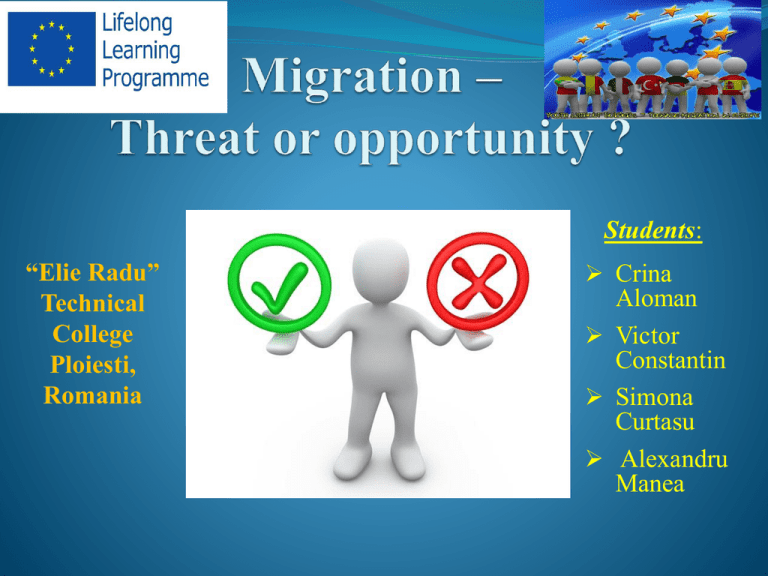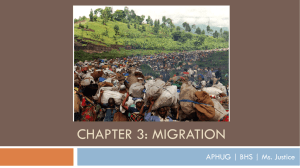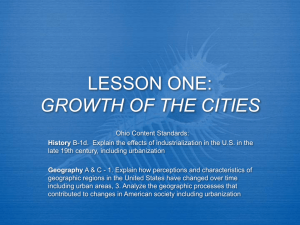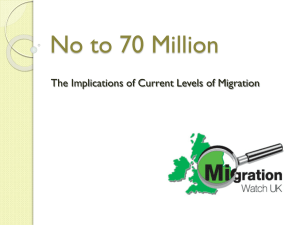Migration – Threat or opportunity-ROMANIA
advertisement

Students: “Elie Radu” Technical College Ploiesti, Romania Crina Aloman Victor Constantin Simona Curtasu Alexandru Manea Human migration: basic notions and facts human migration - a movement of humans from one place to another, with the intention of settling in the new location. some modern migration - a byproduct of wars, political conflicts, and natural disasters. contemporary migration is predominantly economically motivated. number of international migrants - 220 million in 2013; it could reach 405 million by 2050. 1 of every 35 persons in the world is a migrant. Pre-modern migrations Historical migration of human populations: begins with the movement of Homo erectus out of Africa across Eurasia about a million years ago; Homo sapiens appear to have occupied all of Africa about 150,000 years ago; Homo sapiens moved out of Africa 70,000 years ago, and had spread across Australia, Asia and Europe by 40,000 years BC; migration to the Americas took place 20,000 to 15,000 years ago; by 2,000 years ago, most of the Pacific Islands were colonized. Modern migrations: why do people migrate? Reasons for migrating: • Economic Migrants – few opportunities to earn money in their own country. Leave to seek higher paid and more regular wages in more developed countries. • Political Migrants – refugees from civil wars, or a persecuted minority within their own country; seeking safety. • Social Migrants – seeking a better opportunity for their future lifestyle. Often affects families seeking a future with more opportunities for their children. Factors causing migrations Push Factors: not enough jobs ■ few opportunities ■ primitive conditions■ ■ desertification ■ famine or drought ■ political fear or persecution ■ slavery or forced labour ■ poor medical care ■ loss of wealth ■ natural disasters ■ death threats ■ pollution ■ bullying ■ war ■ discrimination. Pull factors: job opportunities ■ better living conditions ■ political and/or religious freedom ■ enjoyment ■ education ■ better medical care ■ attractive climates ■ security ■ family links ■ industry ■ better chances of marrying. Impacts of migration human migration affects: population patterns and characteristics, social and cultural patterns, processes, economies, and physical environments; as people move, their cultural traits and ideas diffuse along with them, creating and modifying cultural landscapes; there are many arguments about the advantages and disadvantages of migration and how it has affected us locally. Positive impacts on host countries (1) job vacancies and skills gaps can be filled; economic growth can be sustained; services to an ageing population can be maintained when there are insufficient young people locally; the pension gap can be filled by the contributions of new young workers and they also pay taxes; immigrants bring energy and innovation; host countries are enriched by cultural diversity; Positive impacts on host countries (2) facilitated growth in the economy; brought benefits to the tourism industry through the development of new air routes; had a positive influence on the productivity or efficiency of local workers; contributed new ideas and a fresh approach to firms; and greater cultural links with developing nations that will prove useful in growing international trade. In addition to these economic benefits: incomers have helped the health and care services to continue functioning; contributed to cultural diversity; increased the vitality, especially of some rural schools. Negative impacts on host countries depression of wages may occur but this seems to be temporary; having workers willing to work for relatively low pay may allow employers to ignore productivity, training and innovation; migrants may be exploited; increases in population can put pressure on public services; unemployment may rise if there are unrestricted numbers of incomers; there may be integration difficulties and friction with local people; large movements of people lead to more security monitoring; ease of movement may facilitate organised crime and people trafficking. Impacts on countries of origin Positive developing countries benefit from remittances (payments sent home by migrants); unemployment is reduced and young migrants enhance their life prospects; returning migrants bring savings, skills and international contacts. Negative economic disadvantage through the loss of young workers; loss of highly trained people, especially health workers; social problems for children left behind or growing up without a wider family circle. Is migration a threat or an opportunity? rapid increase in the number of immigrants worldwide → perception of immigration as a threat to security In the most general sense of the term, security refers to the absence of threats. The following slides → investigate the claim that immigration is a threat to security by focusing on: social, economic public security, arguing that immigration is a constructed and perceived threat rather than a real, objective danger. Immigration and social security social security - ways in which members of a state perceive their cultural, linguistic, religious or national identity to be threatened by immigrants. inability of immigrants to integrate or assimilate → argument for having a negative effect on the society and government’s stability. On the other hand: an immigrant-receiving state may hold a different notion of national identity → may be more tolerant and accepting different languages, cultures, and religions, supporting its policy of multiculturalism. Immigration and economic security labour migration → can be argued to pose a threat to the economic security of both the sending and the receiving state; the emigration of highly skilled and qualified workers from developing countries: “brain drain” in the sending country, undesirable economic consequences in the receiving country. On the other hand: immigration often has a positive impact on the employment levels of the host state. effect of temporary unemployment → dissipates over time, as the state’s economy begins to adjust to the increase in labour supply. Immigration and public security immigration has been related to increased criminality → perception that immigration is a threat to public security. there has been a connection between increased immigration flows and increased crime rates; there is a trend showing that cities and countries that have high crime rates tend to have a higher immigrant population; On the other hand: an abundance of evidence demonstrates that the correlation between immigration and criminality is very weak or non-existent; some studies report: neither wave of immigrants impacted rates of violent crime; immigrant arrest rates were no higher than native arrest rates. Summary and conclusion (1) immigration poses a number of challenges to receiving states; it is inevitable that immigration would be viewed as a threat to society and the economy, as well as to internal security and public order; however, immigration is a perceived threat rather than an objective one. ideas of national identity and notions of which cultural and ethnic groups can be accepted into a community inevitably change over time; the act of labeling immigration as a security threat does more to harm society than it does to protect it; it often results in xenophobic and racist attitudes, the exclusion of immigrant groups, and the perception of the immigrant as the enemy. Summary and conclusion (2) immigration can be beneficial for migrants, but only if their rights are protected properly; immigration can be economically beneficial for both countries of origin and host countries; however, with present economic and trading structures it is the rich and powerful countries that benefit most; migration brings social and cultural pressures that need to be taken into account in planning for future services; migration has the potential for bringing peoples together culturally but friction occurs if efforts are not made to dispel the myths held by local people; it is also essential to provide good information about the local way of life to newcomers and ensure opportunities for people to mix and integrate; where the economic preconditions exist, migration is inevitable. When people try to prevent immigration it just goes underground. References 1. 2. 3. 4. 5. 6. 7. International Organization for Migration: http://www.iom.int/jahia/page3.html http://ec.europa.eu/dgs/home-affairs/elibrary/documents/policies/immigration/pdf/general/emn_immigration_20 06_en.pdf http://www.embraceni.org/migration/the-pros-and-cons-of-migration/ The Economic, Labour Market and Skills Impacts of Migrant Workers www.delni.gov.uk/skillsimpactsmigrantworkers United Nations High Commission for Refugees. Available at url: http://www.unhcr.org/ http://www.e-ir.info/2013/08/24/is-immigration-a-threat-to-security/ International Labour Organization: www.ilo.org








